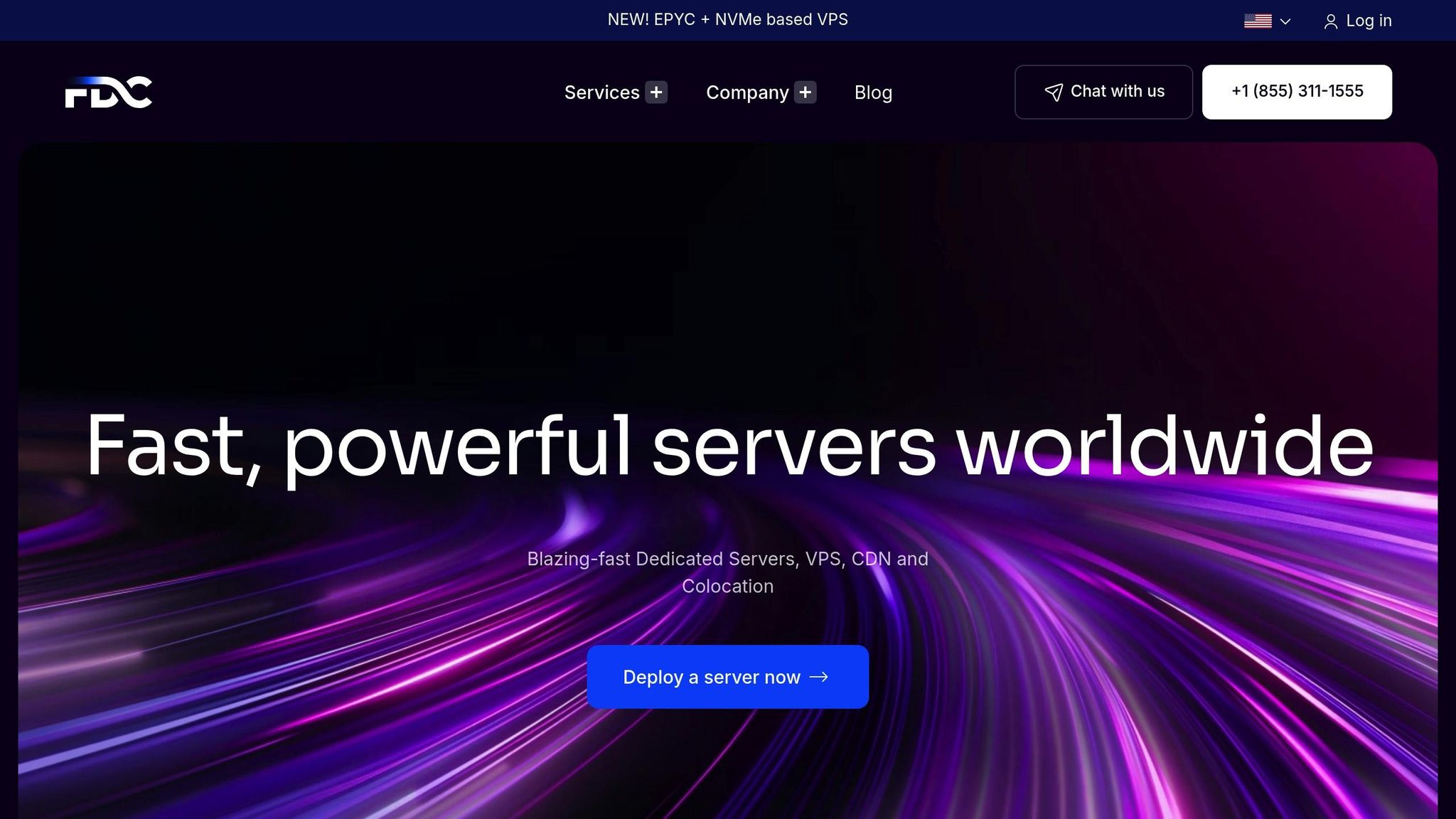NEW! EPYC + NVMe based VPS
9 min read - October 6, 2025

Learn how server location plays a vital role in reducing latency, enhancing user experience, and optimizing performance for various applications.
Server location impacts how fast data travels between your device and the server, directly influencing latency. Here's what you need to know:
Key takeaway: Choosing the right server location is essential for faster load times, better user experiences, and improved performance.
Latency refers to the time it takes for a data packet to travel from your device to a server and back. Imagine asking a question in a crowded room - the pause before you hear the answer is a good analogy for latency.
This delay is measured in milliseconds (ms), and even small differences can have a noticeable impact. For instance, in financial trading, where microseconds can make or break deals, companies invest heavily to shave off even the tiniest delays.
Streaming services also rely on low latency to function smoothly. For live streaming, latency under 5 seconds is crucial for real-time interaction between streamers and viewers. On the other hand, traditional video streaming can handle higher latency since it's not interactive. The difference becomes clear during live sports - high latency might mean hearing your neighbor cheer for a goal before you see it on your screen.
Let’s dive into what causes these delays.
Several factors contribute to latency, and understanding them helps explain why delays occur.
Server placement plays a crucial role in determining latency. The closer a server is to the user, the faster the data transmission.
The concept of edge computing takes this even further. By placing small servers closer to users - sometimes within cell towers or ISP facilities - latency can drop to single digits. This is especially important for applications like autonomous vehicles and augmented reality, where split-second responses are critical.
When it comes to latency, the physical distance between a user and the server plays a huge role in performance. The farther apart they are, the longer it takes for data to make the round trip. Even if a nearby server processes a request instantly, connecting to a distant server naturally takes more time due to the increased round-trip distance. And don’t forget, data doesn’t travel in a perfectly straight line - it passes through various network nodes, each adding small but cumulative delays. This is why choosing server locations closer to users is so critical for reducing latency.
Take streaming services, for example. When they move from a centralized data center to regionally distributed servers, users notice a big difference: less buffering and sharper video quality.
The same applies to competitive online gaming, where every millisecond counts. By hosting servers closer to players, response times improve dramatically, leading to smoother gameplay and a level playing field for all participants.
Picking the right server locations isn’t about guesswork - it’s about using data to make smart, informed decisions. Here’s how to approach it effectively.
The first step is understanding where your users are and how they interact with your website. Dive into your analytics to pinpoint the geographic regions driving the most traffic and revenue. Tools like Google Analytics can help you uncover this data, showing where your audience is located and how engaged they are.
Pay attention to peak traffic times across different regions and time zones. For instance, if one area sees heavy usage during evening hours while another peaks during business hours, you’ll need servers that can handle these varying demands seamlessly.
Don’t just stop at traffic - compare it with revenue data. This will help you prioritize where to invest in reducing latency and improving performance, ensuring your resources are focused where they’ll make the most impact.
Once you’ve analyzed your user data, it’s time to get technical. Network tools can give you a clearer picture of how server locations affect performance. Tools like Pingdom and GTmetrix let you test your site’s loading times from different parts of the world, helping you identify areas with slower response times.
Latency maps are another valuable resource. They provide a visual representation of network performance across regions, highlighting where delays occur. Keep in mind that efficient network routing can sometimes matter more than pure geographic proximity.
If you’re already using a Content Delivery Network (CDN), take advantage of its analytics. Look at which edge locations handle the most requests and achieve high cache hit rates. This data can guide decisions about where to place dedicated servers to complement your CDN setup.
Performance isn’t the only factor - legal requirements also play a big role in server placement. Data sovereignty laws, for example, dictate where certain types of data must be stored. If you serve customers in the European Union, GDPR requires that specific data stays within EU borders, making European server locations a necessity.
In the U.S., state-level regulations like California's Consumer Privacy Act (CCPA) dictate how data for California residents should be handled. Industries like healthcare must also consider laws such as HIPAA, while financial services need to comply with standards like PCI DSS and SOX. Educational institutions, on the other hand, must follow FERPA regulations for student data.
Some countries, including Russia and China, enforce data localization laws, requiring citizen data to remain within national borders. These regulations can significantly influence your server placement strategy.
It’s also important to factor in the cost of compliance. Regions with stricter data protection laws may require extra security measures, frequent audits, and specialized configurations, all of which can increase expenses. Balancing technical performance with legal requirements ensures your servers operate efficiently while staying within the law.
Once you've determined user locations and any legal requirements, the next step is to deploy infrastructure designed to minimize delays. This involves reducing the physical distance between your servers and users through smart, modern methods.
Distributed data centers spread your infrastructure across multiple locations, cutting down the physical distance between servers and users. This approach speeds up data transmission, making it a key strategy for improving performance.
Edge computing takes things further by processing data closer to the user's location instead of routing every request to a distant central server. This is especially useful for real-time applications like online gaming, video conferencing, and live streaming, where even a slight delay can disrupt the user experience.
To complement distributed infrastructures, Content Delivery Networks (CDNs) and Points of Presence (PoPs) offer an effective way to streamline content delivery. CDNs store copies of your website's static content - like images, videos, CSS, and JavaScript - at various PoPs worldwide. When a user visits your site, the CDN delivers content from the PoP nearest to them, reducing load times and easing the burden on your main server.
CDNs and PoPs also optimize traffic by caching assets and routing it through the fastest network paths. This ensures users get quick access to content, even during peak traffic times.

FDC Servers operates a global network spanning over 70 locations, bringing services closer to users. Their unmetered bandwidth model eliminates worries about traffic spikes affecting performance or adding unexpected costs. This allows you to focus on speed optimization without constant oversight. Plus, their instant server deployment lets you scale quickly to meet changing user demands or traffic surges.
FDC Servers offers solutions for a range of needs and budgets. For high-traffic applications, dedicated servers start at $129 per month, while smaller projects can opt for VPS plans starting at $6.99 per month. Their CDN service, priced at $4 per terabyte per month, integrates seamlessly to enhance content delivery. For resource-intensive tasks like AI or machine learning, GPU servers are available starting at $1,124 per month, providing the power and low-latency performance required for demanding workloads.
When it comes to reducing latency, the choice of method depends on striking the right balance between cost, complexity, and scalability. Below, we break down the key methods and their trade-offs to help you make an informed decision.
Here's a side-by-side look at the most common latency reduction techniques:
| Method | Latency Impact | Implementation Cost | Scalability | Technical Complexity | Best Use Cases |
|---|---|---|---|---|---|
| Edge Computing | High | Expensive | Excellent | High | Real-time gaming, IoT, live streaming |
| CDN Integration | Significant | Affordable | Excellent | Low | Static content delivery, media streaming, e-commerce |
| Server Clustering | Moderate | Mid-range | Good | Medium | Database applications, web services |
| Geographic Server Distribution | Strong | Expensive | Excellent | Medium to High | Global applications, multi-region services |
| Network Optimization | Modest | Low | Good | Low | General web applications, APIs |
Edge Computing delivers top-tier latency improvements by processing data closer to the user. However, it comes with steep financial and technical demands, making it ideal for applications where even a tiny delay - like in live gaming or IoT - can be a dealbreaker.
CDN Integration is a more budget-friendly option that still provides significant performance boosts. It's particularly effective for businesses needing to distribute static or media-heavy content to a global audience.
Server Clustering offers moderate latency improvements while adding redundancy and reliability. It's a practical choice for database-heavy operations or enterprise-level systems.
Geographic Server Distribution spreads servers across multiple regions to ensure consistent performance worldwide. While it requires careful planning and higher costs, it's perfect for global services that demand fast response times everywhere.
Network Optimization is a low-cost, low-complexity approach that delivers smaller latency gains. It's a great starting point for general-purpose applications or APIs.
For the best results, you might consider combining methods. For example, pairing CDN Integration with Geographic Server Distribution can significantly enhance performance for global users. Tailoring your approach to your application's specific needs will yield the most effective results.
Where your servers are physically located plays a huge role in shaping user experience and overall business performance. The farther your servers are from users, the longer it takes for data to travel, creating delays that could cost you customers or opportunities.
To get the most out of your digital infrastructure, focus on strategic server placement. Start by analyzing your user base to pinpoint where most of your traffic comes from. Use network monitoring tools to identify latency issues, and keep an eye on any regulations that might affect where your data can legally be stored.
Combining different solutions often yields the best results. For example, pairing a Content Delivery Network (CDN) with servers spread across key regions can significantly cut down latency. If your application requires real-time responsiveness, edge computing may also be worth considering. Whatever approach you take, consistently optimizing for reduced latency should be a priority.
FDC Servers makes this process easier with their network spanning 70+ global locations. They offer tailored plans, unmetered bandwidth to handle traffic spikes, and 24/7 support to keep everything running smoothly. Their infrastructure is built for quick deployment and custom configurations, making it simpler to meet your performance needs.
Investing time in selecting the right server locations delivers real benefits - faster load times, happier users, higher conversion rates, and a stronger competitive edge. Your users expect seamless, responsive experiences, and with a well-thought-out server placement strategy, you can consistently meet those expectations.
Keep testing server locations, track performance metrics, and refine your approach based on actual user data. The rewards in reduced latency and improved user satisfaction will be clear.
To keep latency low and ensure better performance, it's best to pick a server location that's close to where most of your users are. The closer the server is to your audience, the less distance the data has to travel, which means faster delivery. Proximity plays a big role in cutting down latency.
It's also important to evaluate the network infrastructure and the number of hops data takes to reach your users. Running a geolocation analysis of your audience can give you insights into where your traffic is coming from. With this information, you can choose a data center that's in or near that region to achieve the best results.
When deciding on a server location, data sovereignty and the legal framework of the hosting region should be top of mind. Each country has its own set of laws that govern how data is stored, processed, and protected. For instance, some nations enforce strict data localization policies, which mandate that specific types of data must remain within their borders.
Laws like the GDPR in the EU or other regional privacy regulations can add additional layers of complexity. These rules may include restrictions on transferring data across borders, requirements for keeping data within the region, or adherence to particular security protocols. Ignoring these legal obligations can lead to hefty fines or operational headaches. To avoid these risks, it's essential to thoroughly research the legal requirements of your chosen server location and ensure your operations align with all relevant regulations.
Edge computing and Content Delivery Networks (CDNs) work hand in hand to cut down latency by positioning data and services closer to users. This approach shortens the physical distance that data must travel, leading to quicker response times and smoother experiences - especially for real-time applications like video streaming, online gaming, and video conferencing.
With edge computing, data is processed near the user at the edge of the network, eliminating the need to send it back to a central server. On the other hand, CDNs focus on storing and delivering cached content, such as images and videos, from local servers, making frequently accessed resources readily available. When combined, these technologies boost speed, improve reliability, and elevate the overall user experience.

Explore the best monitoring tools for dedicated servers and VPS in 2025, focusing on AI, automation, and real-time analytics.
12 min read - November 28, 2025

Flexible options
Global reach
Instant deployment
Flexible options
Global reach
Instant deployment